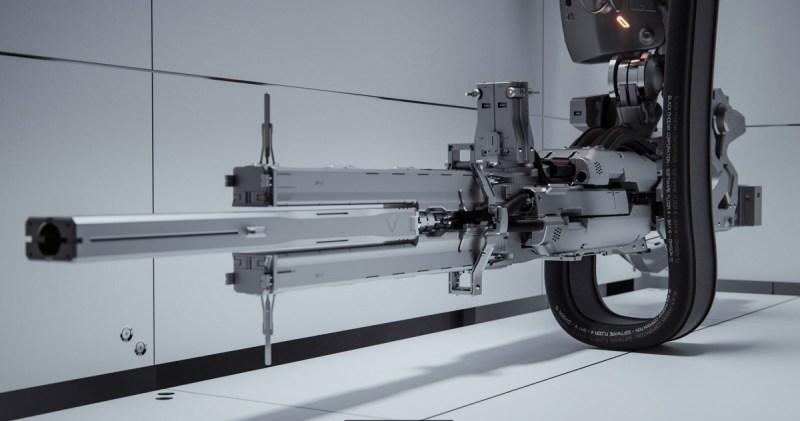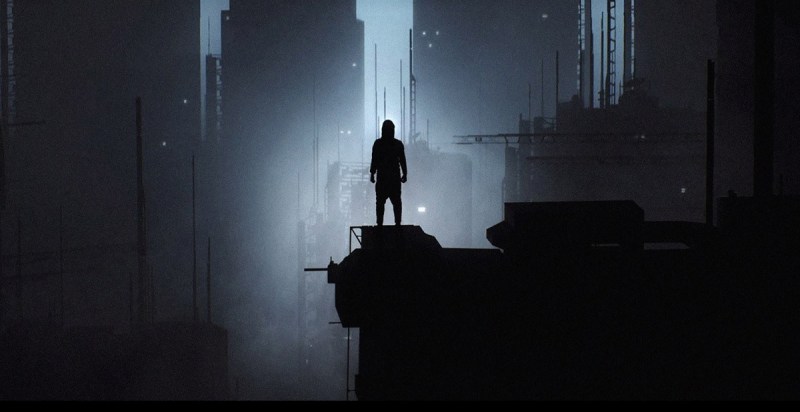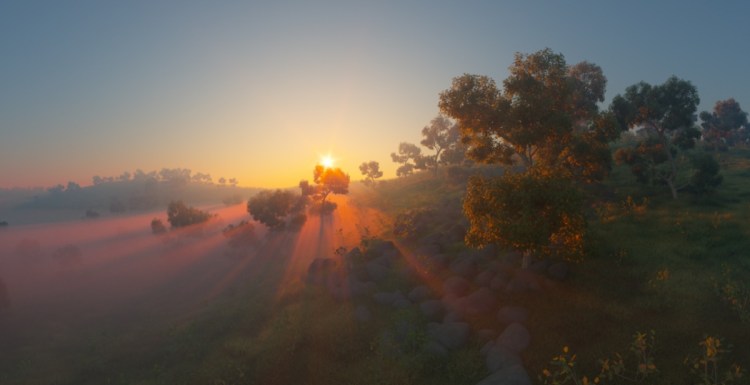
Above: Meanwhile in the R&D Department by Vitaly Bulgarov.
VB: So now we’re getting into what’s in it for the user. If the user lets their GPU be part of this render farm, they’re getting something back, these tokens?
Urbach: Exactly. The Render token, we chose to base it on Ethereum. You can create your own token on top of Ethereum and, in our case, you can buy those tokens through our token sale on Ethereum. A lot of the tokens we’re going to generate, out of a 537 million total — that may seem like a lot, but it’s not when you realize that even with, at a quarter, those tokens adding up to $134 million, that’s only about a thousand lightfield render jobs. By having an economy of tokens out there, it lets people, when they get the tokens as payment, fulfill rendering work.
The value, outside of authors and people who are using our system — we have millions of customers who use this — there are many more millions out there who are not artists or creators — instead of paying Amazon for a thousand GPUs, you’ll basically get a thousand people and pay them each for that same amount of GPU power. They get paid in Render tokens, which is a unit of currency that has a value that starts from the token sale, but it’s very stable. It can only be leveraged for work. The demand for that work — I view it as almost like electricity or bandwidth. There’s a scarcity of resources.
One thing I’ve learned in 10 years of doing this is that the more computing power you get to your users, at any cost, the more they will use it. That’s basically what we’re unlocking. On another end, there are people spending their effort and energy around mining cryptocurrency. This is going to be the first time I’ve seen anyone matching Ethereum tokens to something that’s really valuable and stable, the demand for processing. This rendering that happens is in demand. We’ll saturate all the graphics card in the public cloud, which can be done, and then start saturating all of that with the blockchain backing this.
VB: You’re starting to remind of Jon Jacobs, with his Neverdie tokens, where he wants people to get paid for playing games.
Urbach: Well, there’s tokens out there for everything now. We see that there’s a lot of silly stuff. I really believe that the blockchain is important, though, and I’m not the only one who sees it that way. There’s an opportunity to create services that are distributed differently, that are discovered differently. However that happens, the blockchain needs to be a part of that. We don’t need to type in a URL where we don’t know what’s at the other end of it. The blockchain itself will store links to files and assets, the chain of authorship, the transactional values. All of that is built into the system.
Our perspective is that the piece that needs to be done is above that, now that you have things like cryptocurrency that are starting to validate and log these transactions. I’m a graphics guy. I want the rendering stack, the visual stack, whatever is built on top of this to work really well. A lot of the concepts, whether it’s games or the Metaverse or virtual anything—like the assets in augmented reality, it’s going to have to look real if it’s going to mix correctly with the real world. That means you’re going to go more toward these high-end lightfield rendering work services, certainly in the next few years. I want to make sure the economy of not just rendering all this work, but also valuing it, is built on something that’s stable. Nothing is more validated than blockchain. That’s not going to change unless the entire internet method invalidates it.
The fundamental services, the ones that are going to make the blockchain successful — just like in the dot-com era, there was a lot of crazy stuff that was built using the bigness, the future impact of what everyone saw the internet becoming. The blockchain has led to a lot of silly ideas that people are throwing out there. The ones that aren’t silly are things like Storj, or Golem, bringing microservices onto the blockchain, also replacing Amazon. Or even Brendan Eich with what he’s doing, which puts ad-viewing metrics and dollars onto the blockchain.
Our part sits next to all of these things. We’re bringing the graphics stack, the visual stack — it’s more than just graphics, because it also deals with taking the real world and creating synthetic scenes that can be mixed and matched. Everything Otoy has been doing in these areas — capturing the world, rendering it, and republishing and streaming it — it all really comes down to a system like this. We can ultimately see a whole new platform being built transactionally.
I do think the trend I see, which is a good trend — when you see how AR is being used by both Apple and Google — certainly with Google they’re explicitly saying that they’ll allow Chrome to be the gateway to their AR core services. That’s great, because it means you’re not going through Google Play. You’re not uploading apps. This is how it should be. The next logical step is that objects, geolocation, all these things are essentially mapped to the blockchain, not the web. Frankly, the web was never designed for this.
Apple is hinting that they may be doing something like that too. They’ve started to introduce things like WebGPU, a browser that takes advantage of your high-end GPU card. That probably means they’re thinking it’s important that they allow the web to start feeding content into ARKit and other things.

Above: Still Life by Raphael Rau
VB: A lot of people out there are concerned about the regulation of ICOs. Can you provide any assurance for anybody who invests in this ICO? What will govern how you’ll use the money raised?
Urbach: The ICO landscape over the past six to eight months has been insane. We’ve made sure to do our due diligence in order to make sure that, one, the token is a valid use case for the blockchain, and two, that the token is meant to provide a real utility without the need for any crazy additional development. You have all these projects launching that basically say, “Hey, here’s an idea. Here’s a paper I wrote about it. We’re gonna go with it.” The team might be well-established, but the company was formed three months ago and there’s no product.
The thing that should give people the most relief and trust in the project is the fact that Otoy has been around for 10 years. We’ve raised this company from where it was to where it is now. This is based on a patent from 2009 that I was thinking about in 2005. The token-based utility system is something we’ve been trying to do for so long, and with blockchain coming to the forefront and the possibility of the network achieving this scalability, it’s a perfect time for this system to be created.
VB: What’s the explanation as to why this is so much easier and essential to do on blockchain as opposed to just raising money through more conventional methods?
Urbach: We’re not any different from a utility token. You have all these ICOs raising money for a specific product. That’s we don’t even call it an ICO. We call it a token sale, because you’re buying into the actual utility that the product offers. We’re in it to build the network. We’re not in it for fundraising.
The most important distinction is, without the blockchain, this stuff is incredibly hard to validate. So much money would have to go into servers to validate these render jobs when you can just store the chain of ownership in the actual block that goes on the blockchain. It makes a lot of sense for us to run the token-based system on the blockchain.
One important point about the trust people have in what we’re doing—I’ve never seen anybody do this with an existing business. Right now, the way it will work for end users, we have something called ORC, which we launched in 2015 as a cloud service to render VR stuff. That’s not going to change after the token sale. That’s basically the interface for people to start a render job remotely on the cloud, whether it’s on the blockchain or not. It’s working. It’s useful. It’s one of the fastest-growing pieces of our business.
The service exists. A lot of people go to the space and try to raise money to build something, to build the service. I already built the service. It’s there. Every single person that’s a customer of ours loves this idea, because they know it’ll make the existing service cheaper. This token sale is to invest in a network. Building that network outside the public cloud, doing it at the scale we’re trying to do it, would be very hard. It’s still hard for us, because we’re looking at adding more cloud service providers besides the big ones. Validating that work, having to deal with customer service when a frame goes bad—that happens, even with Amazon, and we have to deal with it and replace things and give back render credits for that.
Doing this across even hundreds of additional cloud providers that have these render farms is one of these goals I have. But the work to build that system out and validate it and support it—you almost have to build something that’s like a franchise model. “You can now fulfill a render job for a user through this service.” The funny thing is, though, the blockchain does all that work for you. We would have to build something like a token-based system tied to the utility of the work being done.
We still have to do a lot of work, a lot of building, and that’s what the token sale provides for as far as funding. But we love that people trust that work in the blockchain. The blockchain itself, having it grow to this size and this capacity, is enough for us to build off of it. It would be stupid of me not to use Ethereum and the blockchain as it is today, to reinvent the wheel in order to deliver this part of the service.

Above: None by ALT Creative, Ash Thorp, and Christoffer Bjerre.
These tokens are basically about a quarter, versus the $5 per data chunk that we use for work on the centralized cloud. My plan is to build as low as we can go and make sure these chunks are more and more granular. The blockchain makes that possible. If I had to imagine a world where I could tap into millions of graphics cards, I really wouldn’t want to have to deal with paying people in dollars. That payments system is filled with a lot of risk. The blockchain reduces that risk and allows us to go all the way to the maximum scale we can.
The other thing is, people understand that cryptocurrency and token-based systems are valuable. That’s not something we have to explain to people anymore. But the value of what we’re doing, the utility behind what each token represents, is really new. Everyone we’ve talked to about this has come away thinking, “This is the first time someone has leveraged the blockchain for a system of value exchange that’s based on something real.” This adds to something we’ve been building for a decade. It’s not leading up to a decade of work that may or may not happen.
The other thing that’s part of the Ethereum blockchain, different from Bitcoin, is that you can create smart contracts to determine the specific exchange of value, what happens next. It’s hard sometimes to leverage that beyond very simple operations, but the entire rendering system we’ve built is designed to essentially prove that the rendering work was done and the user got what they wanted before anyone gets paid. That transaction system is already in place.
The Ethereum blockchain and the smart contracts aren’t that complicated. “This is a ledger. This is an exchange of work.” Once the person that wants to render a job gets what they need, that exchange of tokens happens. We’re not pushing the blockchain to do anything it’s not currently designed to do. We’re offloading a huge amount of the work and the system to other parts of the rendering layers we have. We’re just connecting the blockchain at the very end of it to validate and deal with the transactions.

